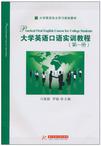大学英语口语实训教程(第一册)
当前位置:首页 > 教材 > 研究生/本专科 > 大学英语口语实训教程(第一册)
出版社:华中科技大学出版社
出版日期:2010-9
ISBN:9787560965802
页数:141页
作者简介
《大学英语口语实训教程(第1册)》内容简介:为适应大学英语教学的新形势,深化教学改革,提高教学质量,满足社会对人才培养的需要,教育部颁发了《大学英语课程教学要求》,作为高等学校非英语专业本科英语教学的主要依据。《大学英语课程教学要求》在论及教学模式改革时指出,“新教学模式应能使学生选择适合自己需要的材料和方法进行学习,获得学习策略的指导,逐步提高其自主学习的能力”。针对这一大学英语教学改革要求,各高校积极探索培养学生自主学习能力的有效途径,创建语言自主学习中心,为学生训练听说能力提供了硬件上的保障。作为大学英语自主学习中心的系列辅助教材,《大学英语口语实训教程》(以下简称《实训教程》)的编写旨在配合大学英语教学改革,努力丰富完善自主学习中心在听说能力培养上的软件建设,为学生在自主环境下培养听说能力给予切实指导。
根据自主学习的特点和要求,《实训教程》在编写上具有以下鲜明的特色。
一、培养学生自主学习的兴趣,话题结合学生生活实际。《实训教程》话题丰富广泛,反映了当代大学生多姿多彩的课内外生活,引入诸多学生感兴趣的讨论主题。结合大学生活不同阶段的特点,《实训教程》分为拥抱校园(Embracing CampusLife)、畅游校园(Enjoying Campus Life)、超越校园(Beyond Campus Life)、走出校园(Farewell to Campus Life)四个分册,贯穿了初识大学校园,爱上大学生活,在校园里成长,告别大学走向社会等全程大学生活。
二、加大语言文化信息输入量,方便学生自由选择利用。在培养听说能力方面,遵循语言输入先于语言输出的规律。《实训教程》为学生提供大量的语言输入,供其自由选择,使其可将更多的精力投入到语言训练的实践中。《实训教程》的输入环节全面涵盖了语言知识、语言技能和文化扩展三个方面。《实训教程》四个分册每单元遵循统一模式,在Word Bank中提供讨论该单元话题所需的词汇及多种口语表达方式;在Demonstration中展示实例对话,演练口语交流技巧;在背景知识和补充材料中介绍与话题相关的文化知识,在Watch&Discuss环节推荐资料库中与话题相关的英文影片供学生欣赏观摩,为学生提供听说学习的文化环境。统一的单元模式为学生口语训练提供了充足的语言材料和文化信息。
书籍目录
Unit 1 Getting to Know Each Other
Unit 2 Finding the Way
Unit 3 College Life:In Class
Unit 4 College Life: After Class
Unit 5 Family
Unit 6 Dorm Life
Unit 7 Foreign Holidays and FesUvals
Unit 8 Dining on Campus
Unit 9 Test
Unit 10 A Nice Vacation
Keys
References
章节摘录
Greeting ( also called accosting) is a way for human beings ( as well as othermembers of the animal kingdom) to intentionally communicate awareness of eachothers presence, to show attention to and to suggest a type of relationship orsocial status between individuals or groups of people coming in contact with eachother. As with many forms of communication, greeting habits are highly culture-and situation-specific and may change within a culture depending on social statusand relationship; the phenomenon as such exists in all known human cultures,though. Greetings can be expressed both audibly and physically, and ofteninvolve a combination of the two. This unit is mainly on the former. Greetings areoften, but not always, used just prior to a conversation.Greetings and Responses When people are introduced for the first time, it is common for them to say"How do you do?". An acceptable reply is "How do you do?". In formalsituations, often "Good morning ! ", "Good afternoon !" or "Good evening !" isused. ( "Good night" is said only when parting or when someone is going to bed)With people of your own age, such as other students or neighb rs, more informalgreetings are used. The most common form of greetings is "Hello!". An evenless formal greeting is "Hi!" If you are meeting a person for the first time, it isalso appropriate to say "Nice to meet you. " After that, it is appropriate to say"How are you? How are you doing?" or "How are things going with you?" Atypical response is "Very well, thank you!" or "Fine, thanks. " If your friendgreets you with "Whats up?" or "Whats happening?", you might reply "Notmuch. " " Nothing special. " or " Same old stuff. " Or, you could quicklysummarize what youve been doing.
图书封面
